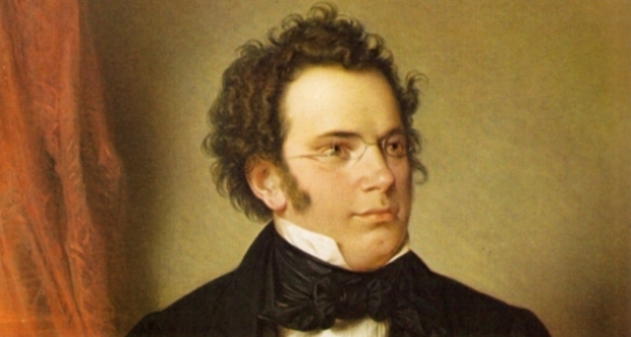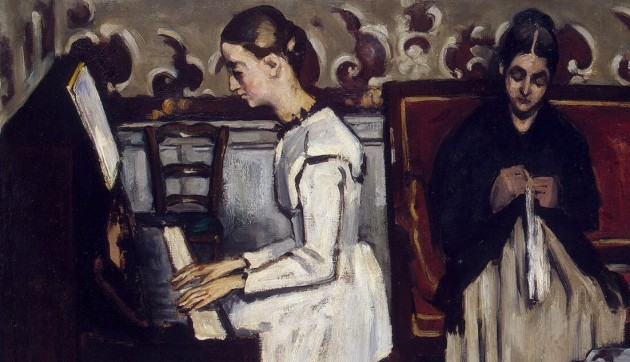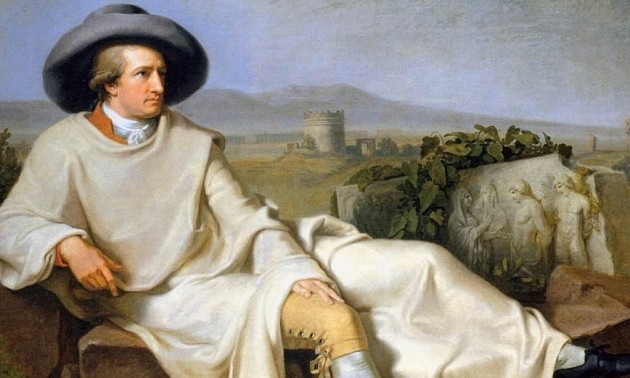Pianissimo
Which as we all know, means “very softly” in Italian. It’s easy to forget that piano wasn’t always a noun, and that the instrument got its name because, unlike the harpsichord which had preceded it, it could produce notes of more than one volume. By Schubert’s time, the instrument hadn’t yet developed into the form that we know today, but was still a strange hybrid known as the fortepiano, which had black keys instead of white, and was missing a couple of octaves. Even though a lot of composers at the time thought that it still needed a lot of improvement, some purists (Historically Informed Performers, or HIPsters as I like to call them) still insist on using the fortepiano. Don’t get me wrong, sometimes it can sound great because you can hear that the composer was using exploiting that specific sound, but for modern ears, it can be a bit wearing, especially since it can end up sounding a bit like something from an old Western.
However you choose to listen to it, there are vast quantities of piano music by Schubert, including 21 piano sonatas. But before I deal with them, I want to highlight a few of the smaller, more popular piano works, starting with the Impromptus, which despite their name are very carefully constructed pieces, full of rippling textures.
Impromptus, Op. 90, No. 2:
Impromptus, Op. 90, No. 3:
Impromptus, Op. 90, No.4:
Impromptus, Op. 142, No. 4:
Klavierstucke No.1:
And if that’s not enough for you, there’s always Michael Nyman’s unusual version of No.3.
The Moments Musicaux are another group of short, popular pieces:
Moments Musicaux, No.1:
Moments Musicaux, No.3:
Moments Musicaux, No.4:
Moments Musicaux, No.5:
The Wanderer Fantasy is very easy to listen to but is actually the most difficult piece Schubert wrote for piano, so difficult in fact that when the composer himself tried to play it to his friends, he gave up half way through. The name fantasy, rather than sonata, implies a freer piece which can roam through a lot of different musical ideas.
Wanderer Fantasy – 1st Movement – Allegro con fuoco
Wanderer Fantasy – 3rd Movement – Scherzo, presto
Wanderer Fantasy – 4th Movement – Allegro
And here’s the haunting Hungarian Melody:
Hungarian Melody
Here are a few of Schubert’s better known piano duets, pieces frequently written for young couples to play together. Firstly the spacious Fantasy in F minor, a melancholy piece which the composer dedicated to his pupil and unrequited love, Karoline Esterházy, who was a member of the same aristocratic Hungarian family who had patronised Haydn for many years. It is one of Schubert’s most significant and innovative pieces:
Fantasy in F minor
Next, the violent Lebensstürme, or Storms of Life:
Lebensstürme
Two pretty Rondos:
Rondo in A major
Rondo in D Major
And finally the speedy finale from the Grand Duo:
Grand Duo, 4th Movement – Allegro vivace
While many of his piano sonatas are worth listening to, it is the last three, written in a flurry just before his death, which really stand out. Like the String Quintet and the 14th String Quartet, these pieces have long been associated with death. They are also amongst Schubert’s most lengthy and subtle works, and take quite a bit of time to get to know really well, but are just as rewarding as Beethoven’s sonatas. Initially the more lively movements stand out, but as you listen more often, the slow movements reveal themselves with incredible poignancy. The first of the trilogy starts in dramatic fashion before eventually finishing on a lighter note with a scurrying final movement.
Piano Sonata No. 19 – 1st Movement – Allegro
Piano Sonata No. 19 – 2nd Movement – Adagio
Piano Sonata No. 19 – 3rd Movement – Minuet, allegro
Piano Sonata No. 19 – 4th Movement – Allegro
The second starts in a similarly electrifying fashion – then the devastating slow movement arrives, bleak and beautiful, followed by the sparkling scherzo and rounded off with a stately finale.
Piano Sonata No. 20 – 1st Movement – Allegro
Piano Sonata No. 20 – 2nd Movement – Andantino
Piano Sonata No. 20 – 3rd Movement – Scherzo, allegro vivace
Piano Sonata No. 20 – 4th Movement – Rondo, allegretto
The third and final sonata starts off on a sombre note, but gradually becomes more dramatic and lyrical over the course of the first movement. The same is true of the second movement, which really gets going after the three minute mark, and is followed by the spirited scherzo. For me though, it’s the last movement which is most interesting – at first it seems as though it’s going to provide some light relief after all the gloom, and although the melody is allowed to run on a little further with each repetition, in the end it is always interrupted by the same note that opened the movement, which rings out like a death-knell. It is as though Schubert is trying to forget some horrible thought at the back of his mind, but it just keeps creeping back in.
Piano Sonata No. 21 – 1st Movement – Molto moderato
Piano Sonata No. 21 – 2nd Movement – Andante sostenuto
Piano Sonata No. 21 – 3rd Movement – Scherzo, allegro vivace con delicatezza
Piano Sonata No. 21 – 4th Movement – Allegro, ma non troppo
And if you enjoy those, sonatas thirteen to eighteen are also worth investigating.
Lieder of the Pack
“Schubert was the most poetic composer who ever lived” – Franz Liszt.
Still wondering where the Trout Quintet and Death & The Maiden got their names? The answer is quite simple – they both use variations of songs by Schubert with those titles. Schubert was a prolific writer of songs, or more accurately, a setter of songs, because he rarely wrote his own lyrics, but preferred to put existing poems to music. In German, this particular form of Romantic art song is called a Lied, and while the tradition of writing Lieder truly began with Beethoven, it was Schubert who brought the genre to maturity. Even if you’ve never heard of Lieder, you’ve probably known one of them all your life, without realising it, because it is so ubiquitous that people assume it simply existed without needing to be composed:
Brahms – Wiegenlied (Lullaby)
Now, I don’t expect you to like Lieder – at least not straight away. It’s hard enough to get people into opera, never mind some weirdly melodramatic German warbling. It can be a bit of a stretch to appreciate these pieces, which sometimes have no resemblance to more familiar 20th century songwriting. But these songs were Schubert’s most popular works during his own lifetime, and the ones which perpetuated his fame long after his death. Moreover, the ideas Schubert developed in his Lieder had a profound impact on his other works, particularly the chamber pieces, and the fact that he sometimes wrote over a hundred songs a year shows the extent to which they dominated his compositional practice. As Dvorak said, “He introduced the song into the symphony.” Schubert once met with a group of fellow composers who had all written songs for the occasion, but he had forgotten to produce anything, so wrote a song from scratch while they waited! If you want to really understand Schubert, you have to listen to the Lieder. If you have trouble with them, you can always listen to Liszt’s solo piano versions, or try thinking back to when you first heard someone like Joanna Newsom and thought “What the hell is this?” but then eventually realised how great it was. Then multiply that kind of thinking several times over, add a bit of relativism, remember how much aesthetics change over decades, never mind centuries, and it’ll all make sense to your ears. Hopefully.
Generally speaking, the vocal part carries the tune and the expression, while the piano part serves as a background, but is often imbued with some evocative little phrase, suggesting everything from a galloping horse to an old man with a hurdy-gurdy.
Schubert wrote two important cycles of Lieder – Die Schöne Müllerin (The Beautiful Miller’s Daughter), followed by the supremely bleak Winterreise (Winter Journey). I don’t think it’s going too far to call them the concept albums of their time, as they both use a continuous set of poems to tell coherent stories of lost love and alienation, not to mention becoming obsessed with the colour green and drowning yourself… It’s not vital to understand the words, as the poems aren’t always particularly good, but it does help to have a vague idea of what’s going on. Here are a few highlights from both cycles:
Die Schöne Müllerin –
Das Wandern (The Walk):
Mein! (Mine!)
Der Jäger (The Hunter)
Danksagung an den Bach (Thanksgiving to the Stream):
Trockne Blumen (Dried Flowers)
Des Baches Wigenlied (The Stream’s Lullaby)
Winterreise –
Gute Nacht (Goodnight):
Der Lindenbaum (The Linden Tree)
Der Leiermann (The Hurdy Gurdy Man/The Organ Grinder) – the last song in the cycle, in which the story’s protagonist meets an old, penniless musician in the middle of nowhere, and asks to join him on his journey. Possibly Schubert’s most haunting composition – listen out for the eerie piano motif which mimics the hurdy-gurdy. It was also used in In Bruges.
And here’s a smattering of the better-known freestanding Lieder. Some of the slower ones sound oddly like jazz:
Die Forelle (The Trout):
Die Erlkönig (The Erl-King) – a spooky tale from Goethe in which the singer plays several different characters using different vocal registers:
Gretchen am Spinrade (Gretchen at the Spinning Wheel) – where the piano part imitates the constant motion of the wheel
Ständchen (Serenade)
An Sylvia – which is taken from a speech by Shakespeare
Heidenröslein (Wild Rose):
In Spring (Im Frühling):
Der Doppelgänger – in which a man revisits an old haunt, only to find his double waiting for him there. As pianist András Schiff has said, “there is more drama in this two minutes than in the entire output of Richard Wagner”:
Death and the Maiden (Tod und das Mädchen):
Fischerweise:
To Music (An die Musik):
The Muse’s Son (Der Musensohn):
Bliss (Seligkeit):
The Boatman (Der Schiffer)
The Passing Bell (Das Zügenglöcklein)
While Schubert’s masses are well regarded, there are a pair of religious works by the composer that have become much more famous, and they are a fitting place to finish.
Gott ist mein Hirt (The Lord is my Shepherd):
Ave Maria (Hail Mary)
Previous Classicals:
#1: Roll Over Beethoven: An Introduction to Beethoven
#2: Rock Me Amadeus: An Introduction to Mozart
#3: Tch-Tch-Tch Tchanges: An Introduction to Tchaikovsky
#5: Bach To The Future: An Introudction to Bach





